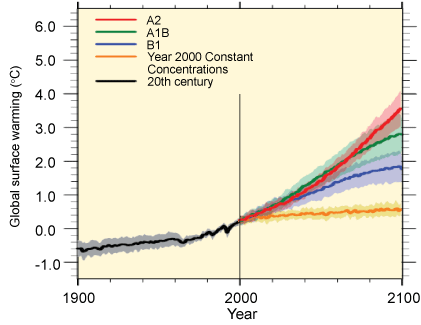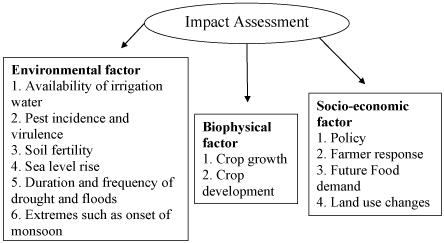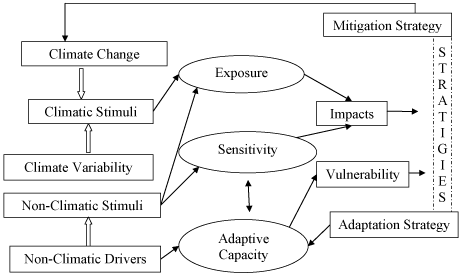Research Article Open Access
Climate Change in Context of Indian Agricultural Sector
| Anupam Khajuria* and N.H. Ravindranath | |
| Centre for Sustainable Technologies, Indian Institute of Science, Bangalore, India | |
| Corresponding Author : | Anupam Khajuria Centre for Sustainable Technologies Indian Institute of Science Bangalore 560012, India E-mail: khajuriaanu@gmail.com |
| Received March 28, 2011; Accepted May 18, 2012; Published May 21, 2012 | |
| Citation: Khajuria A, Ravindranath NH (2012) Climate Change in Context of Indian Agricultural Sector. J Earth Sci Climate Change 3:110. doi: 10.4172/2157-7617.1000110 | |
| Copyright: © 2012 Khajuria A, et al. This is an open-access article distributed under the terms of the Creative Commons Attribution License, which permits unrestricted use, distribution, and reproduction in any medium, provided the original author and source are credited. | |
Visit for more related articles at Journal of Earth Science & Climatic Change
Abstract
Climate has played significant role in the economic development of India. India has tremendous reasons to be concerned about the impacts of climate change. Its large populous country depends on climate-sensitive sectors like agriculture and forestry for livelihoods. Agriculture is facing ecological and economical challenges. The major effects can be generalized as changes in the geographical limits to agriculture, changes in crop yields and impacts on agricultural system. Indian agriculture is particularly sensitive to climate change and variability. The purpose of this article is to understand the issue of impact and assesses the vulnerability of agriculture sector. A range of adaptation strategies make the opportunity to improve the agriculture management in the context of climate change for sustainable development towards the climate resilient pathways.
| Keywords |
| Climate change; Agriculture; Impact; Vulnerability; Adaptation |
| Introduction |
| Climate change is not only a major global environmental problem, but it is also an issue of great concern to a developing country like India. As stated by the Intergovernmental Panel on Climate Change (IPCC), climate change is “Unequivocal” [1]. The IPCC projected a global average temperature rise of 4.2°C under the BAU (Business-As- Usual) emissions scenario (A1B) towards the end of the 21st century, while new studies project a warming of more than 6°C under the current BAU emissions scenario over the same period (Figure 1) [2]. |
| Climate change affects the balance of natural eco-systems (i.e. forests, river basins, sea level) and socio-economic systems (i.e. agriculture, fisheries, irrigation and power projects). The lacks of resources, technology and finances in developing countries such as India have limited capacity to develop and adopt strategies to reduce their vulnerability in climate change. It is widely accepted that the poorest are disproportionately vulnerable to climate change and the least able to adapt [3,4]. Agriculture plays a key role in overall economic and social well being of India. Though the share of agriculture in both Gross Domestic Product (GDP) and employment has declined over time, the pace of decline in its share in employment has been much slower than that of GDP. The research on the impact of climate change and vulnerability on agriculture is a high priority in India as the changes in temperature and precipitation (Table 1). In this article, we studies about the assessment of impacts and vulnerability of climate change and develop the policies of adaptation strategies to cope up the reduction of climate effect on Indian agriculture. |
| Indian Agriculture: Scenario, Impacts and Vulnerability Assessment |
| Scenario |
| The food grain production in India has increased spectacularly due to the Green Revolution from 50 Mt in 1951 to 212 Mt in 2002 and the mean cereal productivity has increased from 500 kg per ha to almost 1800 kg per ha. The share of agricultural products in exports is also substantial with 15% of export earnings. Agricultural growth also has a direct impact on poverty eradication and is an important factor in employment generation. The wheat accounts for one-third of the total food grain production, while rice forms 43% of the total and is cultivated in 43 mha (million hectares), which is about 30% of the net cultivated area [5]. |
| Impact |
| Agriculture is extremely vulnerable to climate change. Indian agriculture faces the dual challenge of feeding a billion people in a changing climatic and economic scenario. Even it is the main source of livelihood for almost 60% of the country’s total population. The impacts of climate change on agriculture will be severely felt in India. It has been projected that under the scenario of a 2.5°C to 4.9°C temperature rise, rice yields will drop by 32%-40% and wheat yields by 41%-52%. This would cause GDP to fall by 1.8%-3.4% [11]. Agricultural productivity is sensitive in two broad classes of climate-induced effects (a) direct effects from changes in temperature, precipitation, or carbon dioxide concentrations and (b) indirect effects through changes in soil moisture and the distribution and frequency of infestation by pests and diseases. The impact assessment can be assessed with the three major factors i.e. Environmental, Biophysical and Socio-economic factors (Figure 2). |
| Vulnerability |
| Vulnerability is the degree to which a system is susceptible to or unable to cope with adverse effects of climate change including variability and extremes [12]. Other definition, vulnerability is a function of the character, magnitude and rate of climate change and the degree to which a system is exposed, along with its sensitivity and adaptive capacity [13]. The vulnerability of agricultural production to climate change depends not only on the physiological response of the affected plant but also on the ability of the affected socio-economic systems of production to cope with changes in yield as well as with changes in the frequency of droughts or floods. The effect of climate change depends not only on the magnitude of climate stimuli or their effects but also on the sensitivity and capacity of the affected system to cope with or adapt to such stress are illustrates by the assessment framework of impact and vulnerability assessment (Figure 3). |
| Vulnerability to Key Driver |
| Vulnerability of agriculture as the land sector is particularly related with the rain fed agriculture which is expected to increase with decreasing precipitation. Rapid population growth will raise food demand and further industrialization of developing countries could lead to massive migration from rural to urban areas. Some key indicators of agriculture as the land sector are given below with their specifications (Table 2). |
| National Action Plan of Climate Change and Other Policies Particularly Agriculture |
| The action plan outlines a number of steps to simultaneously advance India’s development and climate change-related objectives. The Prime Minister’s Advisory Council on Climate Change has outlined a National Action Plan or Climate Change (NAPCC) was released by the Prime Minister in June 2008 and encompasses a range of measures [14]. It focuses on eight missions, which are as follows: |
| 1. National Solar Mission |
| 2. National Mission for Enhanced Energy Efficiency |
| 3. National Mission on Sustainable Habitat |
| 4. National Water Mission |
| 5. National Mission for Sustaining the Himalayan Ecosystem |
| 6. Green India Mission |
| 7. National Mission for Sustainable Agriculture |
| 8. National Mission on Strategic Knowledge for Climate Change |
| National Mission for Sustainable Agriculture is one the eight missions in the NAPCC aims to support climate adaptation in agriculture through the development of climate-resilient crops, expansion of weather insurance mechanisms and agricultural practices. The mission focuses on four areas that are relevant for the endeavours of India’s agricultural sector to adapt to climate change: |
| • Dry land agriculture |
| • Risk management |
| • Access to information |
| • Use of technology |
| The other policy is National Agriculture Policy, 2000 aims to attain over the next two decades a growth rate in excess of 4% per annum in the agriculture sector. The policy explicitly recognizes that agricultural growth should cater to domestic markets and maximize benefits from exports of agricultural products in the face of the challenges arising from economic liberalization and globalization [15]. |
| Adaptation Strategies |
| Adaptation is needed to prepare communities, regions, countries and societies for the consequences of climate change. Adjustment in human and natural systems in response to natural and non-natural climate stimuli or their impacts that moderate harm or exploit beneficial opportunities. Adaptation in the agriculture sector addresses is to reduce the farmer’s vulnerability and improve their adaptive capacity (Table 3). |
| Sustainable Development Towards the Climate Resilient Pathways |
| Sustainable development within the context of climate change calls for new approaches to development that takes into account complex interactions between climate and society. Climate-resilient pathways recognize that impacts are certain because climate change can no longer be avoided. A variety of complex issues in assessing climate-resilient pathways in a variety of regions at a variety of scales: sustainable development as the ultimate aim, mitigation as the way to keep climate change impacts moderate rather than extreme and adaptation as a response strategy to cope with impacts that cannot be avoided. |
| Pathways for sustainable development become more climate-resilient by risk management and vulnerability reduction strategies that include (a) Mitigation reducing the net rate of growth of Green House Gas (GHG) emissions and stabilizing or reducing their concentrations in the atmosphere and (b) Adaptation- improving capacities to cope with climate changes without disruptions of systems that we value. The linkage of adaptation and mitigation seems to be very clear in agricultural sector. Agriculture plays a dual role in climate change. It is a sector that will be severely affected by a changing climate and it also significant contributor to global GHG emissions. The agriculture sector directly combines 14% of total GHG emissions. |
| The four basic mechanisms for GHG mitigation in agriculture: |
| • Reducing methane and nitrous oxide emissions from agricultural production. |
| • Producing different forms of biomass for energy use as a substitute for fossil energy sources. |
| • Supporting forests through reforestation, aforestation and agroforestry. |
| • Storing carbon by increasing soil carbon content. |
References
|
Tables and Figures at a glance
| Table 1 | Table 2 | Table 3 |
Figures at a glance
 |
 |
 |
| Figure 1 | Figure 2 | Figure 3 |
Relevant Topics
- Atmosphere
- Atmospheric Chemistry
- Atmospheric inversions
- Biosphere
- Chemical Oceanography
- Climate Modeling
- Crystallography
- Disaster Science
- Earth Science
- Ecology
- Environmental Degradation
- Gemology
- Geochemistry
- Geochronology
- Geomicrobiology
- Geomorphology
- Geosciences
- Geostatistics
- Glaciology
- Microplastic Pollution
- Mineralogy
- Soil Erosion and Land Degradation
Recommended Journals
Article Tools
Article Usage
- Total views: 20270
- [From(publication date):
June-2012 - Nov 04, 2025] - Breakdown by view type
- HTML page views : 14921
- PDF downloads : 5349
